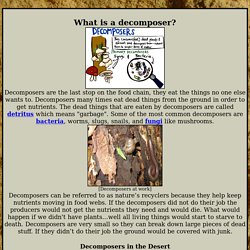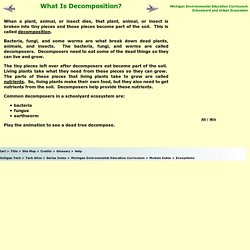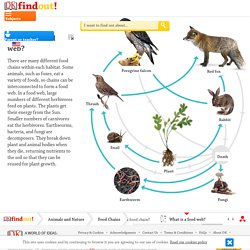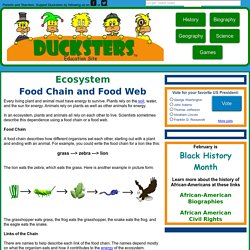

Decomposers. What is a decomposer?

Decomposers are the last stop on the food chain, they eat the things no one else wants to. Decomposers many times eat dead things from the ground in order to get nutrients. The dead things that are eaten by decomposers are called detritus which means "garbage". Some of the most common decomposers are bacteria, worms, slugs, snails, and fungi like mushrooms. [Decomposers at work] Decomposers can be referred to as nature’s recyclers because they help keep nutrients moving in food webs.
Decomposers in the Desert [Beetle] [Earthworm] [Millipedes] In the Desert it is hard for many decomposers to stay alive because they like moist areas. Decomposers in other ecosystems [Bacteria filled water] [Clams] [Freshwater shrimp] There are not many types of decomposers in the water. Decomposers. Fabulous Fungi Fungi like mushrooms, mildew, mold and toadstools are not plants.

They don't have chlorophyll so they can't make their own food. Fungi release enzymes that decompose dead plants and animals. Fungi absorb nutrients from the organisms they are decomposing! There are over 50,000 species of fungi. Earth to Earth There are over 1,800 species of earthworms. - Our Earth - Composting with worms. It's simple.

The worms are kept in a bin with shredded paper or other biodegradable bedding. You feed them food waste. They digest the waste and bedding then excrete nutrient-rich castings. After a few months, the castings combined with the well-decomposed bedding, become vermicompost -- one of the richest soil improvements around. It will do wonders for plants, flowers, fruit trees and garden vegetables. To start vermicomposting, you'll need four things: a bin for your worms a supply of biodegradable beddinga supply of food wasteand worms, of course. Select the components that are easiest for you to find and maintain. The bin Wooden boxes, metal tubs and plastic basins work well as worm containers, provided they allow for good air circulation -- the secret to an odor-free bin. The bedding Besides giving worms a place to work and rest, bedding helps hold moisture in your box and keeps your scraps under wraps. The worms Now comes the fun part -- choosing your worms.
What Is Decomposition? Whan a plant, animal, or insect dies, that plant, animal, or insect is broken into tiny pieces and those pieces become part of the soil.

This is called decomposition. Bacteria, fungi, and some worms are what break down dead plants, animals, and insects. The bacteria, fungi, and worms are called decomposers. Decomposers need to eat some of the dead things so they can live and grow. The tiny pieces left over after decomposers eat become part of the soil. Common decomposers in a schoolyard ecosystem are: bacteria fungus earthworm Play the animation to see a dead tree decompose. 6 animals that recycle in their everyday lives. How and What Does Nature Recycle Naturally? Food Webs For Kids. Earthworms pull leaf litter and other rotting remains from the surface of the soil into their burrows.

They break down the remains as they feed on them. When living things die, they stop taking energy from the food chain. But their dead bodies can provide energy for other creatures and nutrients that help plants to grow. Plants get their energy directly from the Sun, so they are often at the bottom of the chains that form a food web. The song thrush is found from Western Europe to Siberia. The garden snail feeds on plants. This predator dive-bombs other birds, killing them in the air. The red fox is found in most parts of the world.
Food Web: Facts (Science Trek: Idaho Public Television) “Time for dinner” is a welcome sound to just about everyone.

Whether it is pizza, roast chicken, a crisp apple, a cold slice of watermelon or another favorite food, most of us enjoy eating. Food Energy But eating is not just for the good tastes it brings. Eating food gives us the energy we need to live. This energy powers everything you do from playing a favorite sport to studying for a math test or goofing around with your friends. So, where does all this energy come from? Producers To understand food chains and food webs, we must start with where the energy begins. Because plants make so much energy, they are called “producers”. Primary Consumers Animals that eat only plants are herbivores. Think about you eating a fresh tomato out of your family's garden.
Science for Kids: Food Chain and Web. Every living plant and animal must have energy to survive.

Plants rely on the soil, water, and the sun for energy. Animals rely on plants as well as other animals for energy. In an ecosystem, plants and animals all rely on each other to live. Scientists sometimes describe this dependence using a food chain or a food web. Food Chain A food chain describes how different organisms eat each other, starting out with a plant and ending with an animal.
Grass ---> zebra ---> lion.